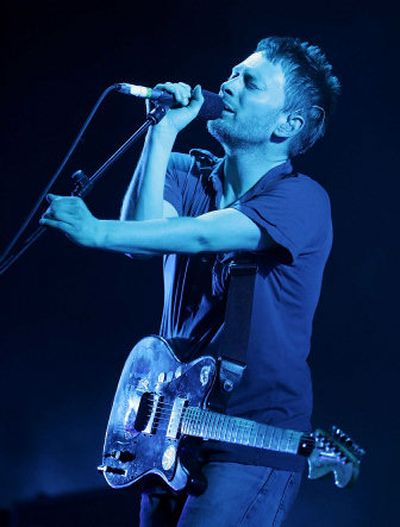Radiohead singer finds new freedom

Last year, Thom Yorke was supposed to unwind.
Radiohead was on hiatus after a protracted cycle of recording and touring. Yorke was savoring the retreat from what he wryly calls “making RECORDS, in big capital letters” and the chance to reacquaint himself with his Oxford home, his longtime partner Rachel Owen and two young children.
But instead of clearing a space for calm, Yorke found himself up to his neck in new thoughts.
“At my house, there’s a room about this size,” he said, gesturing at the spacious suite in San Francisco’s Clift Hotel where he sat discussing “The Eraser,” the album he released Tuesday.
“The entire room was just covered, the whole floor, with notes and scraps of paper. A friend of mine came by just before we started recording, and he was just looking through it, laughing his head off, saying, ‘How are you going to piece this together?’ “
Yorke’s workroom mess, mirrored by the sonic “bits and bobs and shreds of all sorts of random chaos” on his laptop, gave him a sense of freedom he’d momentarily lost within Radiohead.
In league with two longtime collaborators, visual artist Stanley Donwood and producer Nigel Godrich, Yorke enclosed himself amid these fragments, shutting out other influences.
The fruitful little island of disarray contrasted radically with the high-stakes mood surrounding Radiohead’s most recent chart-topper, 2003’s “Hail to the Thief.”
Made quickly, during a time when he was becoming deeply involved with the environmentalist group Friends of the Earth, “The Eraser” is a return to focus for Yorke, whose energy had flagged under the weight of his band’s outsized reputation.
“It was done in the context of Radiohead,” he said, adding that he initially dreaded telling his bandmates he’d embarked on the effort.
“The best thing about it was that it wasn’t a problem (for them). Of course it was fine. Why wouldn’t it be?”
On its current tour, Radiohead is playing a wide swath of favorites plus some exciting new material, perhaps enriched by the confidence Yorke says he’s regained by making “The Eraser,” released on the super-hip independent label XL.
Radiohead is one of pop’s highest-profile free agents, having parted with EMI, the conglomerate that released its previous seven albums. “The Eraser” could be viewed as part of a larger move toward independence.
A project the label-resistant Yorke hates to term “solo,” what began as a side trip into the abstract electronic music he loves became, to the singer’s surprise, 40 minutes of remarkably powerful and direct music.
Sure to be one of the year’s critical and cult favorites, “The Eraser” is an evocative portrait of life made slippery by urban sprawl, murky political alliances and global warming – and given hope through individual and communal resistance – with the blips and bleeps of Yorke’s laptop excursions coalescing into soulful, politically charged songs.
“In the midst of it all there were two or three things that made Nigel and me go, ‘Ooh, there’s something really direct here. Someone might even understand it the first time around.’ ” Yorke says.
The leap beyond the band context might easily have led him into murky territory. A fan of experimental electronica, Yorke first came up with a collection of tracks that didn’t really reach out.
“It made complete sense to me, but there wasn’t enough there for anybody else,” he said. But the desire to meld his voice with the computer’s led to unexpected intimacies.
“The music, no matter what way you look at it, is coming out of a box,” said Yorke, noting that even the acoustic sounds of piano, guitar and bass on “The Eraser” are computer-processed.
He cites Bjork’s 1997 electro-torch suite “Homogenic” as a primary reference point.
“It has its own space,” Yorke said. “We consciously decided to not expand it beyond that. … The record was built to be listened to in an isolated space – on headphones, or stuck in traffic.”
The traffic reference is no casual one for Yorke, whose concern about the environment nearly caused him, at one point, to “flip my lid.”
Its songs send up warning flares that are cosmic in scope, yet movingly personal – the sonic equivalent of a hand held up to a tidal wave.
That’s an image Donwood included in “London Views,” the “apocalyptic panorama” inspired by “The Eraser,” which makes up the album’s cover art.
One of the linotype’s most powerful segments depicts King Canute, the legendary English monarch who proved the limits of kingly power by trying and failing to command the ocean.
“In the paper one day, (British environmentalist) Jonathan Porritt was basically dismissing any commitment that the working government has toward addressing global warming, saying that their gestures were like King Canute trying to stop the tide,” Yorke said.
“And that just went ‘ka-ching’ in my head. It’s not political, really, but that’s exactly what I feel is happening. We’re all King Canutes, holding our hands out, saying, ‘It’ll go away. I can make it stop.’ No, you can’t.”